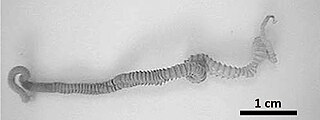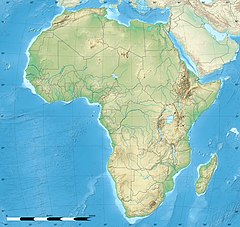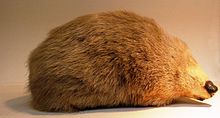
Acanthocephala is a group of parasitic worms known as acanthocephalans, thorny-headed worms, or spiny-headed worms, characterized by the presence of an eversible proboscis, armed with spines, which it uses to pierce and hold the gut wall of its host. Acanthocephalans have complex life cycles, involving at least two hosts, which may include invertebrates, fish, amphibians, birds, and mammals. About 1,420 species have been described.

The giant golden mole is a small mammal found in Africa. At 23 centimetres (9.1 in) in length, it is the largest of the golden mole species. This mole has dark, glossy brown fur; the name golden comes from the Greek word for green-gold, also the source of the name of the family, Chrysochloridae.
Apororhynchus is a genus of small parasitic spiny-headed worms. It is the only genus in the family Apororhynchidae, which in turn is the only member of the order Apororhynchida. A lack of features commonly found in the phylum Acanthocephala suggests an evolutionary branching from the other three orders of class Archiacanthocephala; however no genetic analysis has been completed to determine the evolutionary relationship between species. The distinguishing features of this order among archiacanthocephalans is a highly enlarged proboscis which contain small hooks. The musculature around the proboscis is also structured differently in this order. This genus contains six species that are distributed globally, being collected sporadically in Hawaii, Europe, North America, South America, and Asia. These worms exclusively parasitize birds by attaching themselves around the cloaca using their hook-covered proboscis. The bird hosts are of different orders, including owls, waders, and passerines. Infestation by an Apororhynchus species may cause enteritis and anemia.

Gigantorhynchus is a genus of Acanthocephala that parasitize marsupials, anteaters, and possibly baboons by attaching themselves to the intestines using their hook-covered proboscis. Their life cycle includes an egg stage found in host feces, a cystacanth (larval) stage in an intermediate host such as termites, and an adult stage where cystacanths mature in the intestines of the host. This genus is characterized by a cylindrical proboscis with a crown of robust hooks at the apex followed by numerous small hooks on the rest of the proboscis, a long body with pseudosegmentation, filiform lemnisci, and ellipsoid testes. The largest known specimen is the female G. ortizi with a length of around 240 millimetres (9.4 in) and a width of 2 millimetres (0.08 in). Genetic analysis on one species of Gigantorhynchus places it with the related genus Mediorhynchus in the family Gigantorhynchidae. Six species in this genus are distributed across Central and South America and possibly Zimbabwe. Infestation by a Gigantorhynchus species may cause partial obstructions of the intestines, severe lesions of the intestinal wall, and may lead to death.
Mediorhynchus is a genus of small parasitic spiny-headed worms. Phylogenetic analysis has been conducted on two known species of Mediorhynchus and confirmed the placement along with the related genus Gigantorhynchus in the family Gigantorhynchida. The distinguishing features of this order among archiacanthocephalans is a divided proboscis. This genus contains fifty-eight species that are distributed globally. These worms exclusively parasitize birds by attaching themselves around the cloaca using their hook-covered proboscis. The bird hosts are of different orders.

Moniliformis is a genus of parasitic worms in the Acanthocephala phylum.
Promoniliformis is a monotypic genus of acanthocephalans containing a single species, Promoniliformis ovocristatus, that infests tenrecs in Madagascar. The genus PromoniliformisDollfus and Golvan, 1963 is characterized by possessing two distinct kinds of proboscis hooks. There is only one species in this genus.

Oligacanthorhynchida is an order containing a single parasitic worm family, Oligacanthorhynchidae, that attach themselves to the intestinal wall of terrestrial vertebrates.
Dendronucleata is a genus of small parasitic spiny-headed worms. It is the only genus in the family Dendronucleatidae. This genus contains three species that are distributed globally, being collected in North America and Asia. The distinguishing features of this genus among Archiacanthocephalans is the presence of randomly distributed dendritically branched giant hypodermic nuclei. Dendronucleata parasitize freshwater fish and a salamander by attaching themselves in the intestines using their hook covered proboscis and adhesives secreted from cement glands.
Euzetacanthus is a genus in Acanthocephala.
Australiformis is a monotypic genus of acanthocephalans containing a single species, Australiformis semoni, that infests marsupials in Australia and New Guinea. Its body consists of a proboscis armed with hooks which it uses to pierce and hold the gut wall of its host, and a long trunk. This genus resembles species in the genus Moniliformis but is characterized by a lack of spiral muscles in the outer wall of the proboscis receptacle. The proboscis is armed with 12 rows of 13 to 15 hooks which are used to attach themselves to the small or large intestines of the host. The female worms range from 95 to 197 millimetres long, virtually all of which is the trunk, and 1.75 to 3.5 millimetres wide. There is pronounced sexual dimorphism in this species as females are around twice the size of the males whose trunks range from 46 to 80 millimetres long and 2 millimetres (0.079 in) wide. Infestation by A. semoni may cause debilitating inflammation of the stomach (gastritis) with granulomatous ulcers.
Prosthenorchis is a genus of parasitic worms belonging to the family Oligacanthorhynchidae. Prosthenorchis have a trunk up to 50 mm long, a proboscis that is not ornate with three barbed hooks in each of 12 rows. They have complex hook roots with large manubria, and a small discoid posterior hook base. There are up to 23 festoons. Gonopore is subterminal. The primary host are primates in South America and Felidae in Africa with cockroaches and beetles as intermediate hosts.

Oncicola is a genus of parasitic worms belonging to the family Oligacanthorhynchidae. Oncicola belongs to the phylum Acanthocephalans that include many thorny-headed worms. This family contains 12 genera including the genus Oncicola. Oncicola is a part of the phylum Acanthocephalans that include many thorny-headed worms. The name comes from the prefix onc- meaning “barbed” and -cola meaning “to inhabit” in Latin. It was named and discovered in 1916 by Travassos. These worms are defined by their parasitic nature which involves hook structures found at their front end.

Macracanthorhynchus, also known as the giant thorny-headed worm of swine, is a member of the Oligacanthorhynchidae which contains four species.
Multisentis is a monotypic genus of acanthocephalans. It contains a single species, Multisentis myrmecobius , parasite of the numbat from which it derives its species name. It was found in south-western Australia.
Neoncicola is a genus of parasitic worms containing nine species and belongs to the family Oligacanthorhynchidae.
Oligacanthorhynchus is a genus of parasitic worms belonging to the family Oligacanthorhynchidae.
Atactorhynchus is a genus in Acanthocephala which contains two species, A. verecundus and A. duranguensis.
Cathayacanthus is a genus in Acanthocephala.
Intraproboscis is a monotypic genus of acanthocephalans that infest African black-bellied pangolin in the Central African Republic. Its body consists of a proboscis armed with hooks which it uses to pierce and hold the gut wall of its host, and a long trunk. It contains a single species, Intraproboscis sanghae. This genus resembles species in the genus Mediorhynchus but is characterized by infesting a mammal instead of birds, and having a simple proboscis receptacle that is completely suspended within the proboscis, the passage of the retractor muscles through the receptacle into the body cavity posteriorly, absence of neck, presence of a parareceptacle structure, and a uterine vesicle. The proboscis is armed with 34–36 rows of 6 to 7 hooks anteriorly and 15–17 spinelike hooks posteriorly which are used to attach themselves to the intestines of the host. The female worms are up to 180 millimetres long, virtually all of which is the trunk, and 2 millimetres wide.








